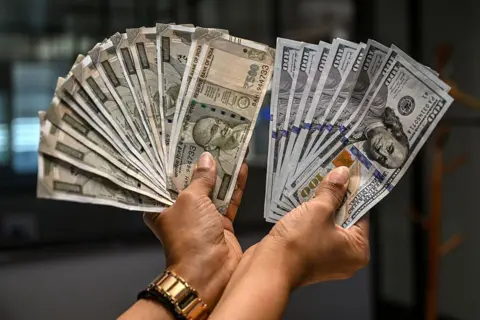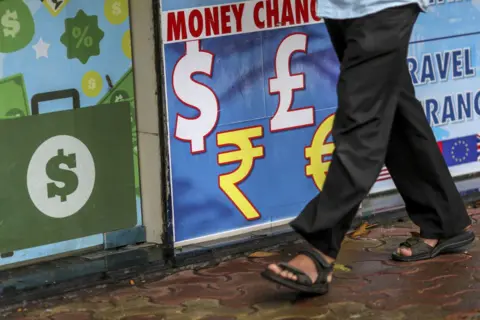India leads in remittances - but Trump's tax could deal a blow
 AFP via Getty Images
AFP via Getty ImagesTucked deep in Donald Trump's sprawling "One, Big, Beautiful Bill Act" is a clause that could quietly take billions from money sent abroad.
It proposes a 3.5% tax on remittances sent abroad by foreign workers, including green card holders and temporary visa workers such as those on H-1B visas. For India - the world's top remittance recipient - the implications are serious, say experts. Other major recipients include Mexico, China, the Philippines, France, Pakistan and Bangladesh.
In 2023, Indians abroad sent home $119bn (£88bn) - enough to finance half of India's goods trade deficit and outpace foreign direct investment, according to a paper by Reserve Bank of India (RBI) economists. Of this, the largest share came from the US. For millions of migrants, that includes the money wired to cover a parent's medicine, a nephew's tuition or a mortgage back home.
A blunt levy on remittances could skim billions from migrant workers, many of whom already pay taxes in America. The likely result? A rise in informal, untraceable cash transfers and a dent in India's most stable source of external financing.
India has remained the top recipient of remittances since 2008, with its share rising from 11% in 2001 to 14% in 2024, according to World Bank. India’s central bank says that remittances are expected to stay strong, reaching an estimated $160bn by 2029. The country's remittances have consistently hovered around 3% of GDP since 2000.
India's international migrant population grew from 6.6 million in 1990 to 18.5 million in 2024, with its global share rising from 4.3% to over 6%. While the Gulf still hosts nearly half of all Indian migrants, skilled migration to advanced economies - especially the US - has increased significantly, driven by India's global IT footprint.
The US remains the top source of remittances worldwide, with its share rising from 23.4% in 2020–21 to nearly 28% in 2023–24, driven by a strong post-pandemic job recovery and a 6.3% rise in foreign-born workers in 2022. Notably, 78% of Indian migrants in the US work in high-earning sectors such as management, business, science, and the arts.
Remittance costs - driven by fees and currency conversion - have long been a global policy concern due to their impact on families. While global averages of the costs remain above targets, India stands out as one of the most affordable destinations, reflecting the rise of digital channels and heightened market competition.
 AFP via Getty Image
AFP via Getty ImageA 10-15% drop in remittances could cost India $12-18bn a year, tightening dollar supply and putting pressure on the rupee, according to Ajay Srivastava of Delhi-based think tank Global Trade Research Initiative (GTRI). He reckons the central bank may have to step in more often to stabilise the currency.
The bigger blow would land on households in states such as Kerala, Uttar Pradesh and Bihar, where remittances fund essentials like education, healthcare and housing. The tax could "hit household consumption hard" even as the Indian economy grapples with global uncertainty and inflation, Mr Srivastava says in a note.
The remittance tax could squeeze Indian household budgets, dampen consumption and investment, and undermine one of India's steadiest sources of foreign exchange, warns a brief by the Delhi-based Centre for WTO Studies. Maharashtra, followed by Kerala and Tamil Nadu, continues to be among the dominant recipient states.
Remittances in India are largely used for household consumption, savings and investment in assets like housing, gold and small businesses. according to a policy brief by the think tank's Pritam Banerjee, Saptarshee Mandal and Divyansh Dua.
A drop in inflows could shrink domestic savings and reduce investment in both financial and physical assets. When remittance inflows decline, households are likely to "prioritise consumption needs (e.g. food, healthcare, and education) over savings and investment", the brief says.
 Getty Images
Getty ImagesA study by Center for Global Development, a Washington-based think tank, suggests the proposed tax could sharply cut formal transfers, with Mexico facing the biggest hit - over $2.6bn annually. Other major losers include India, China, Vietnam and several Latin American nations like Guatemala, the Dominican Republic and El Salvador.
To be sure, there's still some confusion surrounding the tax, and final approval is pending Senate action and the President's signature.
"The tax applies to all non-citizens and even embassy and UN/World Bank staff. But those who pay taxes can claim a tax credit. Thus, the remittance tax would apply only to those migrants who do not pay taxes. That would mostly include unauthorised migrants (and diplomats)," Dilip Ratha, the World Bank lead economist for migration and remittances, told the BBC.
Dr Ratha wrote in a note on LinkedIn that migrants would try to cut remittance costs by turning to informal methods - hand-carrying cash, sending money through friends, couriers, bus drivers or airline staff, arranging local currency payouts via friends in the US, or using hawala, hundi and cryptocurrencies.
"Will the proposed tax deter unauthorised immigration to the US? Will it encourage unauthorised migrants to return home?" wonders Dr Ratha.
Not quite, he says. A minimum wage job in the US earns over $24,000 a year - roughly four to 30 times more than in many developing countries. Migrants typically send home between $1,800 and $48,000 annually, estimates Dr Ratha.
"A 3.5% tax is unlikely to deter these remittances. After all the main motivation for migration - migrants trying to cross oceans and rivers and mountains - is to send money home to help helpless family members."
